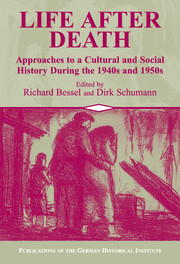Book contents
- Frontmatter
- Introduction Violence, Normality, and the Construction of Postwar Europe
- 1 Post-Traumatic Stress Disorder and World War II
- 2 Between Pain and Silence
- 3 Paths of Normalization after the Persecution of the Jews
- 4 Trauma, Memory, and Motherhood
- 5 Memory and the Narrative of Rape in Budapest and Vienna in 1945
- 6 “Going Home”
- 7 Desperately Seeking Normality
- 8 Family Life and “Normality” in Postwar British Culture
- 9 Continuities and Discontinuities of Consumer Mentality in West Germany in the 1950s
- 10 “Strengthened and Purified Through Ordeal by Fire”
- 11 The Nationalization of Victimhood
- 12 Italy after Fascism
- 13 The Politics of Post-Fascist Aesthetics
- 14 Dissonance, Normality, and the Historical Method
- Index
11 - The Nationalization of Victimhood
Selective Violence and National Grief in Western Europe, 1940-1960
Published online by Cambridge University Press: 05 January 2013
- Frontmatter
- Introduction Violence, Normality, and the Construction of Postwar Europe
- 1 Post-Traumatic Stress Disorder and World War II
- 2 Between Pain and Silence
- 3 Paths of Normalization after the Persecution of the Jews
- 4 Trauma, Memory, and Motherhood
- 5 Memory and the Narrative of Rape in Budapest and Vienna in 1945
- 6 “Going Home”
- 7 Desperately Seeking Normality
- 8 Family Life and “Normality” in Postwar British Culture
- 9 Continuities and Discontinuities of Consumer Mentality in West Germany in the 1950s
- 10 “Strengthened and Purified Through Ordeal by Fire”
- 11 The Nationalization of Victimhood
- 12 Italy after Fascism
- 13 The Politics of Post-Fascist Aesthetics
- 14 Dissonance, Normality, and the Historical Method
- Index
Summary
The concept of this book seems to start from an implicit but inescapable acknowledgment. Compared to the over-specialization, the fragmentation, the technicality, and finally the undeniable overproduction of the historiography on World War II, the history writing on World War I is remarkably advanced in producing an integrated, intellectually ambitious analysis of the experience of the war and its impact on post-1918 Europe. This historiography attained a comparative European scale, and it reached into the realms of social and cultural history. Mechanized warfare during four long years had brought violence on an unprecedented scale. Mass-mobilization, massive casualties, and an entire generation traumatized by mutilation, shell-shock, and the experience of daily horror had profoundly impregnated European societies with the experience of this war, including a home front of mourning widows and orphans, of depleted villages, factories, and neighborhoods. The experience, moreover, had been fundamentally identical for all belligerents, and it had thereby unified the European continent through a common fratricidal cataclysm. The widow and the soldier, the German and the British, had all, somehow, lived the same war. Even if these European societies chose in the two decades following the war very different paths – aggressive fascism or pacifisme municheois – victors and vanquished initially had to cope with a very similar legacy of mass death, mutilation, and war trauma.
- Type
- Chapter
- Information
- Life after DeathApproaches to a Cultural and Social History of Europe During the 1940s and 1950s, pp. 243 - 258Publisher: Cambridge University PressPrint publication year: 2003
- 2
- Cited by



